(Feb 6, 2016) Photos From Volcano Irazú In Costa Rica.








(Feb 6, 2016) Photos from Volcano Irazú in Costa Rica.
More Posts from Simplyphytoplankton and Others

DISCOVERING THE GIANTS OF THE DEEP: BATHYNOMUS JAMESI
A newly discovered species of giant isopod, Bathynomus vaderi, has recently been described from the deep waters around Spratly Islands, off Vietnam. The species, named after the infamous Sith Lord, Darth Vader, due to the striking resemblance of its helmet-like head, adds to the growing diversity of the Bathynomus genus. Bathynomus vaderi is characterized by several unique features, including a parallel-margin clypeal region, a raised dorsal surface on its pleotelson, and upwardly curved pleotelson spines.
Giant isopods like Bathynomus vaderi have become an expensive delicacy in Vietnam. Until 2017, local fishermen only sold them as an incidental product at low prices, but in recent years the media has drawn the public's attention to this unusual seafood. Some even claim that it is more delicious than lobster, the "king of seafood." This new species is described from several individual found at seafood markets in Hanoi, Vietnam.

-Seafood market in Hanoi, Vietnam, selling the newly described Bathynomus jamesi. Large specimens exceeding 2 kg in weight command premium prices.
In Vietnam, Bathynomus species, are often referred to as "sea bugs". Their unique appearance and large size make them a delicacy, and they can command high prices, with larger individuals of B. vaderi reaching up to 2 kg. In recent years, demand for these creatures has risen, especially in urban centers like Hanoi and Hồ Chí Minh City, where they are displayed in restaurants and sold through online seafood markets. This growing industry highlights the continued fascination with deep-sea species and the need for ongoing research to better understand their ecology and conservation.
Main photo: Bathynomus vaderi, male, colour in life. Photo by Nguyen Thanh Son
Reference (Open Access): Ng et al., 2025. A new species of supergiant Bathynomus A. Milne-Edwards, 1879 (Crustacea, Isopoda, Cirolanidae) from Vietnam, with notes on the taxonomy of Bathynomus jamesi Kou, Chen & Li, 2017. ZooKeys.
What’s one of the best places in the world to find white sharks?

Greater Farallones National Marine Sanctuary.
Located in California north and west of San Francisco, the sanctuary is home to one of the most significant populations of white sharks on the planet. The waters around the Farallon Islands in particular provide critical feeding areas for the sharks’ annual migration.

So how do researchers in the sanctuary study the sharks? One way is to use a decoy shaped like a seal with a GoPro attached. When the shark investigates the decoy, the researchers can get the images they need to identify the shark.


Learn more about white sharks in Greater Farallones National Marine Sanctuary on the sanctuary’s website and in our video:

These people not only vote, they’re the same ones paying $$$ to promote pro-fossil fuel candidates.
I honestly see it as no exaggeration to say that the fate of the planet rests on how - and if - we vote.

Recently, NASA Goddard released a visualization of aerosols in the Atlantic region. The simulation uses real data from satellite imagery taken between August and October 2017 to seed a simulation of atmospheric physics. The color scales in the visualization show concentrations of three major aerosol particles: smoke (gray), sea salt (blue), and dust (brown). One of the interesting outcomes of the simulation is a visualization of the fall Atlantic hurricane season. The high winds from hurricanes help pick up sea salt from the ocean surface and throw it high in the atmosphere, making the hurricanes visible here. Fires in the western United States provide most of the smoke aerosols, whereas dust comes mostly from the Sahara. Tiny aerosol particles serve as a major nucleation source for water droplets, affecting both cloud formation and rainfall. With simulations like these, scientists hope to better understand how aerosols move in the atmosphere and how they affect our weather. (Image credit: NASA Goddard Research Center, source; submitted by Paul vdB)




It’s the biologists turn
Having recently shared images from the Nikon Small World (see http://bit.ly/2xQdOHd) and the Insight Astronomy Photographer of the Year 2017 awards (see http://bit.ly/2ipNvkn), here are some photos from the Royal Society of Biology’s 2017 Photographer of the Year and Young Photographer of the Year competitions in a week of the year that seems to have all these events announcing their honours more or less simultaneously.
Keep reading










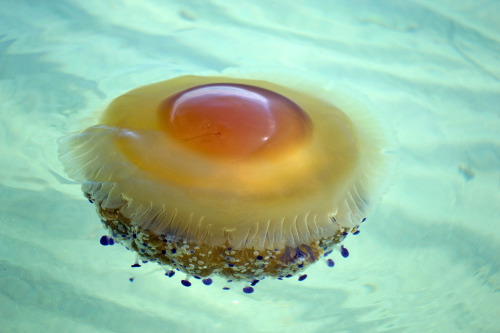

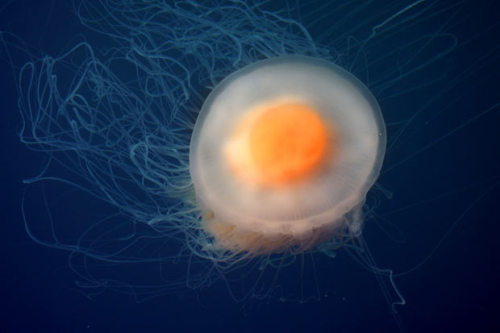
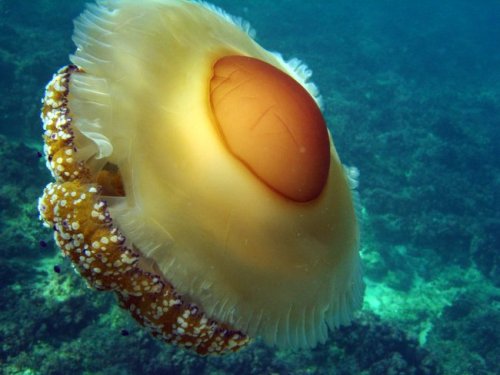
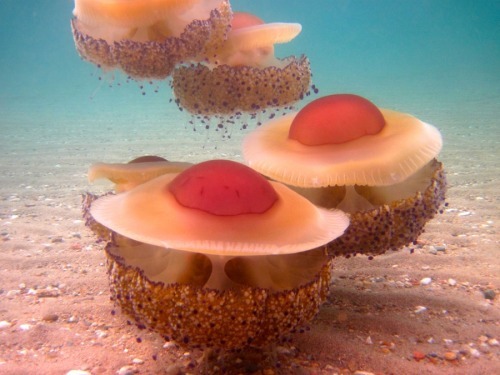
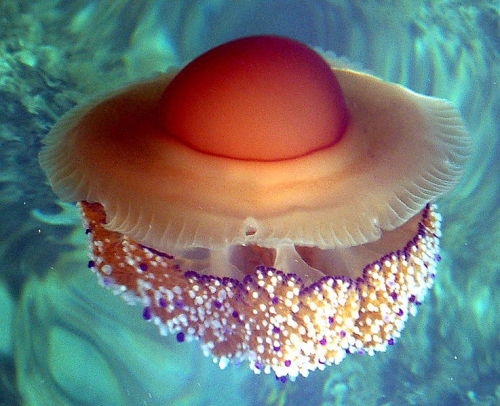
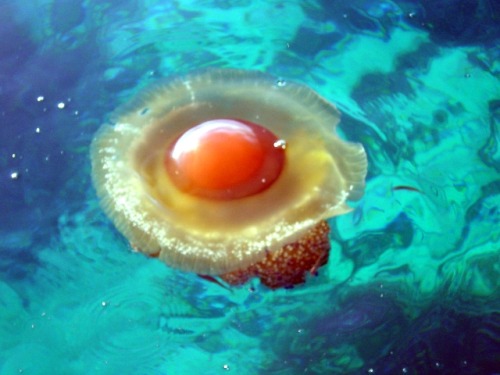
Fried Egg Jellyfish Are Kind of Adorable – & That’s No Yolk.
There are two species that hold the whimsical title of “Fried Egg Jellyfish”: Phacellophora camtschatica and Cotylorhiza tuberculata though the two are quite different from each other in all aspects beside appearance.
Phacellophora camtschatica is a huge jelly that prefers colder waters. It’s bell can reach up to 2 ft across and its dozens of tentacles reach over 20 ft long! If you don’t think this floating egg creature looks very menacing, you’d be right. It has a very weak sting and many small crustaceans take advantage of the jelly by riding on its bell (breakfast to go…?) while snatching up extra food.
Cotylorhiza tuberculata is a much smaller jellyfish that hangs out in warmer waters. It only reaches about 35 cm in diameter, so don’t go for this Fried Egg Jelly if you want a big breakfast. Unlike most jellyfish, C. tuberculata can swim on its own, without relying on the currents for movement. It’s sting (if you can even call it that) is so feeble that it has very little to no effect on humans at all. I mean, it does look like a breakfast food, after all… how powerful could it be?
Pyrosome passing through #ClearAPathPeople
Pyrosomes are colonial tunicates made up of thousands of individuals known as zooids. Each zooid is housed in the common gelatinous tunic that makes up the larger cylindrical “body” of the pyrosome. Zooids filter phytoplankton through branchial baskets by creating feeding currents through the tunic. Although each zooid is only a couple of millimeters in size, pyrosomes can reach up to several meters in length. While alive, these organisms spend the majority of their time in the upper water column, but their remains have been found as deep as 4,000 meters (13,120 feet), where they provide food for a variety of deep-sea animals.
Pyrosomes are bioluminescent, producing brilliant blue-green light. Each zooid can detect light and emit light in response, creating waves of bioluminescence up and down the organism’s body. The bioluminescence of one pyrosome can trigger others in surrounding waters, producing beautiful light shows. The name Pyrosoma comes from the Greek term meaning “fire body.”

🐚🐚🐚
-
 ididitforthedogs liked this · 9 years ago
ididitforthedogs liked this · 9 years ago -
 simplyphytoplankton reblogged this · 9 years ago
simplyphytoplankton reblogged this · 9 years ago

Blog dedicted to phytoplankton. Phytoplankton are microscopic organisms that are responsible for half of the photosynthesis that occurs on Earth. Oh, and they look like art... Follow to learn more about these amazing litter critters! Caution: Will share other ocean science posts!Run by an oceanographer and phytoplankton expert. Currently a postdoctoral researcher.Profile image: False Colored SEM image of Emiliania huxleyi, a coccolithophore, and the subject of my doctoral work. Credit: Steve Gschmeissner/ Science Photo Library/ Getty ImagesHeader image: Satellite image of a phytoplankton bloom off the Alaskan Coast, in the Chukchi SeaCredit: NASA image by Norman Kuring/NASA's Ocean Color Web https://earthobservatory.nasa.gov/images/92412/churning-in-the-chukchi-sea
158 posts
